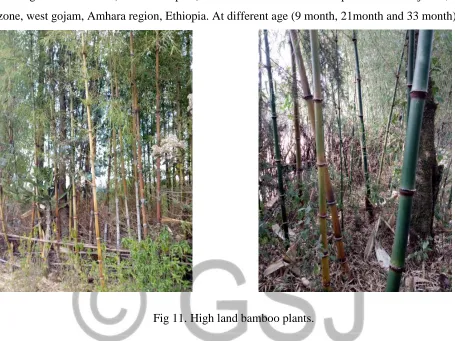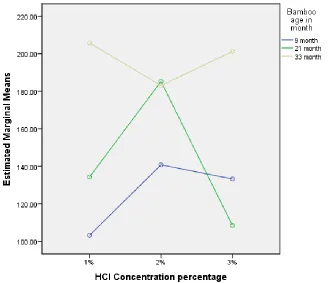Age Effect on the Mechanical Properties of acid
treated Yushania Alpine Bamboo Species
.
Dawit Tessema Ebissa, awwce2005@gmail.com
Ethiopian Institute of Textile and Fashion technology Institute, Bahir Dar University, Ethiopia.
Bamboo has received increasing attention over the last two decades for its economic and
environmental values. In Africa, Asia and Latin America, it is closely associated with indigenous
culture and knowledge and is widely used for housing, forestry, agroforestry, agricultural
activities and utensils. In countries undergoing economic development, traditional bamboo culture
gradually disappears. However, industrial development of bamboo is offering a new opportunity
to younger generations to retain and continue developing cultural traditions related to the
cultivation, harvesting and use of bamboo.
Ethiopia is one of the few countries in the world endowed with a vast bamboo resource base. The
country has an estimated one million hectares of natural bamboo forest, 7% of the world total and
67% of the African total. There is large amount of bamboo distributed in both highland and
lowland areas including areas not suitable for other plants. And also there is a new species ‘jiant
bamboo’ that is cultivated under amhara agricultural research center. Currently these different
bamboo species uses in the country as construction material, for making furniture, and as
livestock fodder whereas, their mechanical properties are not characterized yet. Therefore in
addition to these bamboo applications for advanced industrial development textile and other
energy production all properties have to be characterized for researcher and users. To
characterize, first the fiber is extracted with different extraction method.
In this study, Yushania alpine species bamboo fiber at different age is extracted chemically(acid
HCl tratment) in different concentration and then test their mechanical properties based on
ASTM D3822-07 international fiber testing standard by using FAVIMAT FIBER TEST and
finally Analysis the age effect on the mechanical properties of the bamboo fiber.
1. Introduction
Developing countries those are suited for growing bamboo and aspiring for better welfare and
faster rate of development need to produce and utilize such commodities. Ethiopia is known for
its large amount of bamboo distributed in both highland and lowland areas including areas not
suitable for other plants. And also there is a new species ‘jiant bamboo’ that is cultivated under
amhara agricultural research center. However, unlike other countries, the economic return
obtained from these species is very low. Given the role played by bamboo in the global economy,
the country has not used it even to its minimal potential[1].in different region of the country the
population practices local bamboo for food, charcoal, construction (house, fence) and furniture[2].
Whereas, the extraction and characterization of bamboo fiber is the main duties in the bamboo
utilization process for industrial development and energy production as well as for local purpose.
Fiber characterization is conducting a series of tests in order to assess its general quality and its
specific ability to support a particular application or applications.
2 Bamboo plant
Fig.1 Bamboo plant [3]
Bamboo is a term used to describe a group of large woody grasses (including 1250 species) that
normally grow in warm and humid condition. Bamboos are distributed mostly in the tropic, but
they can naturally live in subtropical and temperate regions except for Europe. Bamboo has been
planted and used by human for thousands of year for many purposes. Bamboo have strong, light
and flexible woody stem. Bamboo fibers are used to make paper, textiles and board. In many
urge of finding alternative energy source to replace fossil fuel, which is running out of stock, a
new way of utilizing bamboo has been added to the list. It is the exploitation of bamboo biomass
as a source to produce different type of energy, for instance, electricity and biofuels[3].
3. Ethiopia bamboo species
Ethiopia has the greatest bamboo resources in Africa representing a significant proportion of
Africa’s total bamboo resources. Ethiopia has more than 1 million hectares of bamboo which is
67% of African bamboo resources and more than 7% of the world total area covered by bamboo
is found in Ethiopia. Ethiopia has two bamboo species namely, Yushania alpine (highland
bamboo) and Oxytenantheriaabyssinica (lowland bamboo)[4].
Lowland bamboo in Ethiopia grows only in the western part along major river valleys and in the
lowlands bordering Sudan and The coverage of lowland bamboo is estimated to be 1,000,000
hectares [4]. The lowland bamboo has enormous importance for the rural society. Because of the
shortage of proper woody plants for construction in the lowlands, the lowland bamboo is
commonly used as an alternative for timber in house construction, fences and also as fodder for
cattle, human food and as energy supply.The highland bamboo on the other hand grows naturally
in the south, south-west, central and north-west highlands of Ethiopia and the coverage of the
highland bamboo is estimated to be 300,000 hectares[4]. And also there is a new bamboo plant
species ‘‘jiant bamboo’’ which is cultivated by amhara agricultural research center.
4. Mechanical properties of bamboo fiber
The mechanical analysis is the study of a material’s behavior when subjected to loads. The
mechanical properties mainly provided by the cellulose content, which is influenced by many
factors such as age, species type and the extraction methods[5].
Fig.2 variation of bamboo fiber modulus of elasticity (MOE) and tensile strength with age (Moso bamboo
which china bamboo species)[7].
Fig. 3 Variation of bamboo fiber strain with age (Moso bamboo which china bamboo species)[7]
Fig.4 Moisture content of Bangladesh four bamboo species at different height positions and ages[9].
Fig.5 density of Bangladesh four bamboo species at different height positions and ages[9].
5. Methodology
At three different ages (9month, 21month and 33month), at the middle stem around 25 -30 cm
length bamboos will prepare and cleave with slicer to remove residual parts.
Fig.7. High land bamboo at different age
Cutting the sampling in to strip.
Soaking the sample bamboos in acid retting in different concentration
.
Fig.9. Acid treatment at different concentration
From each extraction methods, single bamboo fiber will extract and then characterize their
mechanical properties (tensile strength, modules of elasticity, strain and maximum breaking
applied force) based on the standard of ASTM D3822-07 by using FAVIMAT FIBER TEST Lab
Equipment.
Fig.10. FAVIMAT Fiber Test Lab Equipment.
The interaction effect of age and acid concentration on the mechanical properties of the
6. Experimental Procedure
The high land bamboo (Yushania alpine) was harvested from a local plantation in enjibara, awi
zone, west gojam, Amhara region, Ethiopia. At different age (9 month, 21month and 33 month)
Fig 11. High land bamboo plants.
The internodes of raw bamboo were cut and residual part was cleaved in longitudinal direction to
thin slabs with 25 - 30 cm in length and 2.0 – 2.5mm in thickness by the slicer. Finally, they were
converted manually into fibre bundles. For acid treatment the bamboo fibre bundles were soaked
in 1%, 2%, 3% HCl solution at room temperature for 1 hour. Finally, they were washed with fresh
water and dried under shadow.
And then the fiber bundles cleaned and hammer using plastic mallet to separate the fibres strands
from the lignin.
Finally based on the ASTM D3822 international standard test methods, by using FAVIMAT lab
equipment measured the tenacity, modulus of elasticity, strain and breaking force of the fibers at
7. Result and Discussion
The extraction of fiber from bamboo plant mean that the removal of lignin from the fiber.
The fibre strands of each test were tested and their maximum stress, Young’s modulus and
maximum breaking force of test samples were measured. The samples consist of acid treated
fibres at different age.
Fig.12 shows that the stress strain diagrams of HCl treated different age bamboo fiber with
different concentration the result show that the linearity and yielding point of the stress. And also
for 1% concentration of the fiber have lower yielding point and 3 % concentration fiber have
higher yielding stress.
Fig12. Stress strain diagram of HCl treated fiber at different concentration
Table 3 by taking the significant level α = 0.05 ( the confidence intervals are 95%) the significant
of bamboo fiber age 0.004 < 0.05, for HCl concentration 0.026 < 0.05 and their interaction 0.001
< 0.05 therefore the result show that age change, concentration change and their interaction is
significant for the response (tenacity). And also the adjusted R squared value is 0.817 which
means there is an error but the error have no that much impact on the observed tenacity values.
Fig 13, interaction graph of age and HCl concentration show that the better fiber strength is yield
at 1% concentration and 33 month age of bamboo plant.
8. Conclusion
Various methods have been used to extract fibers based on their application in different fields of
study and industries. In this study only acid treatment extraction method is done. Different factors
have there on impact on the mechanical properties of the bamboo fiber. In this study the effect of
age and concentration on the mechanical properties of the fiber is carried out. from the study the
better fiber strength is yield at 1% concentration and 33 month age of bamboo plant.
The study is carried out on only the high land bamboo plant species and only on the acid
treatment method therefore in the future on the other Ethiopian bamboo species and with other
extraction and treatment methods these mechanical properties and other properties have to be
characterized for better fiber data information and to use for different application mean that for
textile industries and energy production.
7. Reference
[1] YIGARDU MULATU and MENGISTIE KINDU, “Status of bamboo resource development ,
utilization , and research in Ethiopia : A review,” Ethiop. J. Nat. Resour., 2010.
[2] E. Kelbessa, T. Bekele, A. Gebrehiwot, and G. Hadera, “A Socio-Economic Case Study of the
Bamboo Sector in Ethiopia: An Analysis of the Production-to-Consumption System,” no. March,
2000.
[3] T. A. Ha and L. T. M. Anh, “Overview of bamboo biomass for energy production,” 2014.
[4] I. Journal, A. S. Culture, T. Vol, E. Centre, and D. Uk, “REVIEW OF BAMBOO VALUE
CHAIN IN ETHIOPIA Teshome Kassahun (Teshe Dawuro) Agricultural Department of Dawuro
zone, P.O. Box 17, Dawuro, Southern Ethiopia,” vol. 2, no. 3, pp. 52–67, 2015.
[5] K. Rassiah and M. M. H. M. Ahmad, “A Review On Mechanical Properties Of Bamboo Fiber
Reinforced Polymer Composite.pdf,” vol. 7, no. 8, pp. 247–253, 2013.
[6] V. Kaur, D. P. Chattopadhyay, and S. Kaur, “Study on Extraction of Bamboo Fibres from Raw
Bamboo Fibres Bundles Using Different Retting Techniques,” Text. Light Ind. Sci. Technol.,
2013.
[7] H. Yan-hui, F. Ben-hua, Y. Yan, and Z. Rong-jun, “Plant Age Effect on Mechanical Properties of
Moso Bamboo (Phyllostachys Heterocycla Var. Pubescens) Single Fibers,” Wood Fiber Sci., vol.
44, no. 2, pp. 196–201, 2012.
[8] D. Awalluddin et al., “Mechanical properties of different bamboo species,” MATEC Web Conf.,
[9] M. Kamruzzaman, S. K. Saha, A. K. Bose, and M. N. Islam, “Effects of age and height on

